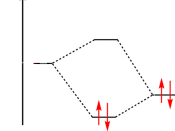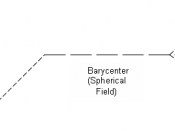Complex ions consist of a metal ion surrounded by anions or molecules known as ligands. Unlike most metals, complex ions form dative bonds, rather than the usual ionic bonds. A dative bond is similar to a covalent bond, but rather than forming a bond with one electron from each atom, the bond is created by the donation of a pair of electrons by one atom or ion. Ligands that have these lone pair electrons behave like Lewis bases which are defined as an electron pair donor. The metal ion in the middle is said to behave like a Lewis acid, which accepts pairs of electrons. The ligands make complex ions non-degenerate because the ligands repel the d-orbitals near them, causing those only those orbitals to increase in energy. There are a few types of complexes, but only complexes with a transition metal ion at the centre will produce coloured solutions.
According to the crystal field theory, the splitting of d-orbitals occurs in transition metal complex ions. It can be assumed that the splitting of d-orbitals is related to the coloured solutions produced.
Complex Structures
There are many complex structures, however only octahedral, trigonal bipyramidal, square pyramidal, square planar and tetrahedral have sp hybridisation. Octahedral, tetrahedral and square planar are more common.
In octahedral complex is defined as a structure containing six ligands arranged around a metal ion. When ligands bond with a transition metal ion, the repulsion between the ligands and the metal's electrons causes the energy of the d-orbitals to increase. Because of the way the d-orbitals are arranged, the energies are raised in different amounts, splitting them into two groups: t2g orbitals ( ) and eg orbitals ( ). The t2g orbitals have greater energy than the eg orbitals.
This diagram shows the energy of the d-orbitals...


